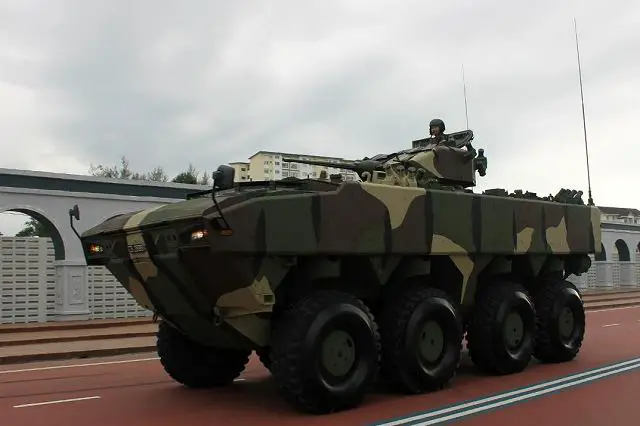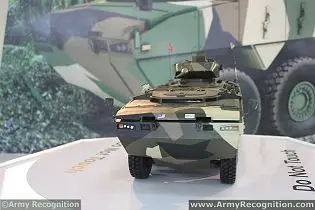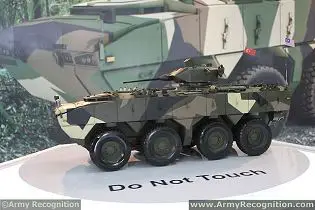The AV8 Gempita is the latest generation of 8x8 armoured vehicle personnel carrier for Malaysian armed forces. The Deftech AV8 is a new generation of Armoured Wheeled Vehicles with special emphasis on mobility, protection, payload and growth potential. Latest designs and technology from the commercial automotive industries which have been militarised to meet the performance and durability of modern military operational requirements. In June 2011, the Turkish Company FNSS has signed a ‘letter of offer and acceptance’ by DRB-Hicom Defence Technologies (Deftech) for the design, development and manufacture of the vehicles. The AV8 vehicle selected by the Malaysian military is based on the FNSS-designed PARS 8×8 multi-purpose, multi-mission, wheeled armored vehicle. The contract includes technology transfer arrangements to Deftech and logistics support for the Malaysian army, positioning the vehicle and its 12 variants to become Malaysia’s first indigenous family of 8×8 armored wheeled vehicle. In April 2012, Deftech and FNSS are presented the first scale model of the AV8 at the International Defence Exhibition, DSA 2012 in Kula Lumpur. Malaysia’s DEFTECH will be the principal assembly agent, and its engineers will work with Nurol holding subsidiary FNSS to customize the vehicles for Malaysian requirements and equipment. South Africa’s Denel will reportedly build a 2-man turret for the APC, while Sapura Thales was expected to become the systems integrator. The first prototype of te AV8 was presented in March 2013 to the public during the 80th Army Day anniversary celebration in Port Dickson, Negri Sembilan. The Malaysian Armed Forces are now assessing the prototype of the future generation of combat armoured vehicle, AV8, before its production commences locally.
|
| Armament |
The AV8 Gempita will be equipped with two types of turret designed and manufactured by the South African Company, Denel. The first is the LCT30, a two man turret with two-axis stabilisation and it is armed with a 30 mm GI-30 cannon and a FN Herstal MAG 58M coaxial 7.62 mm machine gun with elevation from -10° to +30° and 360° traverse. The MAG 58M is a 7.62 x 51 mm NATO machine gun specifically designed and developed by the Belgian Company FN Herstal for pintle type airborne, land and sea applications. It can be installed on FN mount or on the existing mount of the carrier. The MAG58M fires from an open breech to avoid the cook-off phenomenon and is fed with belted ammunition. The rate of fire can be ajusted manually through a gas regulator which ensures a smoothly functioning and overcomes stoppages in adverse conditions. The GI30 is a dual-feed 30x173 mm cannon with an effective range of 3 000 m. It has two firing modes, a closed-breech, single-shot 'sniper mode' for engaging point targets, and a three-round burst mode at 100 rounds/minute for general use. The integrated fire-control system combines a video and thermal sight with three fields of view, an integrated laser range finder, a ballistic computer, an auto-tracker, and touch-screen battle panels for the commander and the gunner. The panels display the sight image, ballistic data and battle management information. The system automatically adjusts for range, cant, target movement, closing rate, meteorological conditions and ammunition characteristics. A laser warning system alerts the crew to threats and can be linked to automatically trigger the electrically discharged grenade launchers to deploy screening agents or HE grenades. A row of four smoke grenade discharger is mounted at the front and rear on each side top of the hull. On single grenade launcher is mounted to each side of the turret and three more on each side at the rear.
The second is the LCT30-ATGW, an antitank variant of the LCT30 which is similar but integrates the beam generator for the Ingwe laser beam-riding missile, mounts elevating twin launchers on either side, and has a different thermal imager lens to allow for the greater engagement ranges. The Ingwe missile from Denel Dynamics business entity, has an effective range of 5,000 m and a tandem shaped-charge warhead that can penetrate up to 1,000 mm of homogenous steel armour protected by reactive armour.
|
| Design and protection |
The hull of the AV8 Gempita consists of a composite aluminium and steel armour that provides a protection for the crew and infantry against firing of small arms 7.62 mm armour-piercing attack through a full 360°. The AV8 is more protected than the basic PARS 8x8 with additional armour mounted at the front and to the sides of the hull. The driver and the commander seats are located at the front of the vehicle, the turret in the middle and the troop's compartment at the rear. There is three large day periscopes at the front position of driver and commander and one on each side that provide excellent visibility. Eleven infantrymen can be seated at the rear of the hull on individual seats down each side of the hull facing inwards. All shock-absorbing seats are fitted with five-point seatbelts as standard. Back of the driver and commander position, there is an access passage to the troop compartment at the right side of the hull. The troops leave and enter the vehicle via a large hydraulic ramp mounted at the rear of the hull.
|
| Propulsion |
|
The AV8 Gempita uses a 8x8 chassis and is motorized with a German Deutz turbocharged diesel engine, developing 550 hp, coupled to a fully automatic transmission with 6 forward and 1 reverse gears. The diesel power pack is mounted to the rear of the driver and commander position on the left side of the hull. The AV8 can run at a maximum road speed of 100 km/h with a maximum cruising range of 700 km. The vehicle can climb up to 60% gradient and vertical obstacle of 0.7 m, move on 30% side slope and cross a trench of maximum 2m.
|
| Accessories |
|
Standard equipment of the AV8 Gempita includes Two thermal cameras and CCD cameras in the front and rear, providing driver/commander with high situational awareness, dual channel Central Tyre Inflation System (CTIS) and run-flat tyre inserts, integrated auxiliary power unit, self-recovery winch, air conditioning, NBC protection system, automatic fire suppression system and land navigation system. the AV8 is fully amphibious and propelled in the water by two waterjets mounted at the rear of the hull.
Thales's high-level expertise in C4ISR systems for land forces will provide the AV8 project with an integrated and scalable vehicle electronic architecture system including a wide range of new-generation equipment (communications, vetronics, sensors, command & control, mortar, optronics, etc.) to meet the rigorous operational performance criteria of the Malaysian Army.
As one of the main integrator of the AV8 Project, Thales roles will be to deliver:
- A state of the art open vehicle electronic architecture designed to optimise integration and enable information exchange (voice, data and video) both within vehicles and externally. It combines a set of sub-systems and specific equipment that assist the commander during the mission (Battlefield Management System), manage the status of the vehicle components (Platform Management System), assist navigation, provide an optimised situational awareness (picture / status / report) and enhance survivability.
- The gunner sight system (DNGS T1) of the Infantry Fighting Vehicles 30mm turret including the optronic suite of all combat variants fitted with the 3rd Generation Thermal Imager (Catherine XP).
- The SQUIRE ground surveillance radar for detection/tracking and classification of moving ground targets on the Surveillance Variant
- TDA's unique 120mm 2R2M Mortar of the mortar variant offering an unmatched range of 13km.
The Reconnaissance AV8 vehicle will be equipped with the Vingtaqs II, a target acquisition and surveillance system from the Company Vinghog which is part of Rheinmetall Nordic AS, former Simrad Optronics ASA. The Company was acquired by the German company Rheinmetall AG in 2010. VINGTAQS II is a vehicle installed target acquisition and surveillance system to be used to accurately determine target coordinates from the vehicle forward observer position The VINGTAQS Fire Control System (FCS) can also be equipped with instrumentation to laser designate targets at a long distance, in the role of supporting the Forward Air Controller (FAC).
The system has a complete sensor package for long range, all weather, all day capability and it can compute target coordinates up to 20 kilometers Maximum detection ranges are 48 km (Radar), 17 km (Day Camera), 15 km (Thermal Imaging Module) The positioning system consists of the Internal Navigation System (INS) and a Global Positioning System (GPS) The INS can be used independently of the GPS The system can be operated while on the move The system can be integrated to most BMS/C4I systems.
Radar images are presented onto map with shown area of radar sweep (when connected to BMS). The detected target is presented onto map. If the radar detects a target the day/thermal camera will automatically turn to the area of the target. The system has Auto Sweep functionality that allows the operator to predefine a number of targets to be surveyed automatically by the sensors. The system has Automatic Video Tracker, Scene Locker, Image Stabilization and Image Fusion (thermal and day channels are presented as overlay). The system has a local hard drive for saving photos and/or videos. The system provides possibility for streaming video and/or sending photos (connected to BMS)
|
| |
| Specifications |
| Back to top |
|
Armament
|
|
One 30 mm, one coaxial machine gun 7.62 mm calibre. Four launcher of Ingwe laser guided anti-tank missile for the LCT30-ATGW turret.
|
|
Country users
|
|
Malaysia
|
|
Designer Company
|
|
FNSS and Deftech
|
|
Accessories
|
|
Firing control computer system, night vision, NBC system, OICS mission, 3rd generation Thermal image Catherine XP, battlefield management system, ground surveillance radar SQUIRE, automatic fire suppression system, land navigation system, air conditioning
|
|
Crew
|
|
3 + 11 soldiers
|
|
|
Armor
|
|
Composite aluminium and steel armour. add-on armour at front and sides of the hull.
a
|
|
Weight
|
|
? kg
|
|
Speed
|
|
100 km/h on road - 6 km/h on water
|
|
Range
|
|
700 km
a
a
a
a
a
|
|
Dimensions
|
|
Length, ? m; Width, ? m; Height, ? m
|
|
|
| |
|
































